As more and more organizations encourage their employees to work from home to mitigate the spread of COVID-19, there’s the risk that they could increase the chance of another virus spreading: malware. Even if your organization has a strong cybersecurity foundation, employees connecting from unpatched and/or compromised home computers dramatically increase the likelihood of credential theft, unauthorized access, data loss and propagation of malware.
Cyberattackers are taking advantage of the influx of remote workers with increased rates of cyberattacks since the coronavirus was declared a pandemic. Our team of cybersecurity experts at Corsica has put together a list of helpful tips for keeping your remote workers secure:
- Wherever possible, restrict network (VPN) access to company-issued and managed computers. These are more likely to be up to date on patches and protected by anti-malware software.
- Ensure that remote computers’ operating systems and applications are fully patched. New vulnerabilities are discovered and announced every day, and each one represents a potential chink in your organization’s armor.
- Ensure all remote computers are running a currently supported operating system. The use of outdated operating systems like Windows XP and Windows 7 dramatically weakens an organization’s ability to defend against cyberattacks.
- Ensure that all remote computers are running some type of anti-malware software (commercial package or built into the operating system) and that signatures are up to date.
- Use a DNS security service such as OpenDNS Home to prevent your users’ computers from being able to resolve and connect to malicious domains. It’s straightforward to implement and doesn’t require advanced technical knowledge.
- Implement multi-factor authentication (MFA) and use it everywhere it’s supported, but particularly in conjunction with publicly accessible services such as Office 365, SharePoint Online, remote-access VPN and the organization’s DNS administration portal. Any computer in the internet-connected world could conceivably attempt to log into these services, and traditional passwords do not provide a sufficient level of protection.
- If your organization uses a mobile device management (MDM) platform, ensure that remote employees’ computers and mobile devices have been registered with it. An MDM platform extends organizational control to remote and mobile devices that have access to company data. It allows an organization to control security parameters and permitted apps, compartmentalize and control company data, and wipe devices that are lost or stolen.
While this article highlights a few technical measures that your organization can take to assist in staying secure while working remote, there is always more that can be done. If you need guidance during the pandemic or need help with strategic leadership on business continuity our experts are here to help. You can reach out to us at corsicatech.com or give us a call at 877.659.2261.
The post Cyberthreat protection: Work from home recommendations appeared first on UPSTATE BUSINESS JOURNAL.






